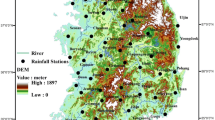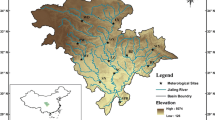Abstract
In a case study in Tao River Basin, China, we derived a high spatial-resolution regional distribution of evapotranspiration (ET) using the single crop coefficient method and Budyko equation. We then further analyzed the spatio-temporal characteristics of this diverse eco-hydrological basin from 2001–2010. The results suggest that the single crop coefficient method based on leaf area index captures better spatial and temporal dynamics of the regional ET than did the Budyko Equation method. The rising temperature was the main reason for the increasing ET in the Tao River Basin during 2001–2010. Areas with high ET efficiency were distributed mainly in the areas where the vegetation coverage was high, and a lower runoff coefficient responded. The estimated spatial patterns of ET allowed an improved understanding of the eco-hydrological processes within the Tao River Basin and the method used might be generalized as a reference for future regional-scale eco-hydrological research.
Similar content being viewed by others

References
Allen R G, Pereira L S, Raes D, et al. 1998. Crop evapotranspiration-guidelines for computing crop water requirements. FAO Irrigation and Drainage Paper 56. Rome
Anderson M C, Hain C, Wardlow B, et al. 2011. Evaluation of drought indices based on thermal remote sensing of evapotranspiration over the continental United States. J Clim, 24: 2025–2044
Budyko M I. 1974. Climate and Life. Miller D H, Translated. San Diego: Academic Press
Chaouche K, Neppel L, Dieulin C, et al. 2010. Analyses of precipitation, temperature and evapotranspiration in a French Mediterranean region in the context of climate change. C R Geosci, 342: 234–243
Cheng D H, Li Y, Chen X, et al. 2013. Estimation of groundwater evaportranspiration using diurnal water table fluctuations in the Mu Us Desert, northern China. J Hydrol, 490: 106–113
Choudhury B J, Ahmed N U, Idso S B, et al. 1994. Relations between evaporation coefficients and vegetation indices studied by model simulations. Remote Sens Environ, 50: 1–17
Conradt T, Wechsung F, Bronstert A. 2013. Three perceptions of the evapotranspiration landscape: Comparing spatial patterns from a distributed hydrological model, remotely sensed surface temperatures, and subbasin water balances. Hydrol Earth Syst Sci, 17: 2947–2966
Donohue R J, Roderick M L, McVicar T R. 2011. Assessing the differences in sensitivities of runoff to changes in climatic conditions across a large basin. J Hydrol, 406: 234–244
Donohue R J, Roderick M L, McVicar T R. 2012. Roots, storms and soil pores: Incorporating key ecoydrological processes into Budyko’s hydroclimatic framework. J Hydrol, 436–437: 35–50
Dooge J C I, Bruen M, Parmentier B. 1999. A simple model for estimating the sensitivity of runoff to long-term changes in precipitation without a change in vegetation. Adv Water Resour, 23: 153–163
Du J, Zhang B, Song K S, et al. 2009. Estimation of evapotranspiration for typical ecosystems in the Bielahong River basin Based on SEBAL (in Chinese). Resour Sci, 31: 1755–1763
Fang X Q, Zhang W C. 2003. The application of remotely sensed data to the estimation of the leaf area index (in Chinese). Remote Sens Land Resour, 3: 58–62
Fu B P. 1996. On the calculation of evaporation from land surface in mountainous areas (in Chinese). Sci Meteorol Sin, 16: 328–335
Galleguillos M, Jacob F, Prévot L, et al. 2011. Comparison of two temperature differencing methods to estimate daily evapotranspiration over a Mediterranean vineyard watershed from ASTER data. Remote Sens Environ, 115: 1326–1340
Han L, Wang P, Yang H, et al. 2006. Study on NDVI-Ts space by combining LAI and evapotranspiration. Sci China Ser D-Earth Sci, 49: 747–754
Huo Z, Dai X, Feng S, et al. 2013. Effect of climate change on reference evapotranspiration and aridity index in arid region of China. J Hydrol, 492: 24–34
Jung M, Reichstein M, Ciais P, et al. 2010. Recent decline in the global land evapotranspiration trend due to limited moisture supply. Nature, 467: 951–954
Kang S Z, Gu B J, Du T S, et al. 2003. Crop coefficient and ratio of transpiration to evapotranspiration of winter wheat and maize in a semi-humid region. Agric Water Manage, 59: 239–254
Katul G G, Oren R, Manzoni S, et al. 2012. Evapotranspiration: A process driving mass transport and energy exchange in the soil-plant-atmosphere-climate system. Rev Geophys, 50, doi: 10.1029/2011-RG000366
Ke T T, Shu L C, Jiao Y, et al. 2011. Derivation and application of Budyko framework based on Fu’s equation at monthly time scale (in Chinese). Adv Sci Technol Water Resour, 31: 38–40
Kite G. 2000. Using a basin-scale hydrological model to estimate crop transpiration and soil evaporation. J Hydrol, 229: 59–69
Li C B, Li W Y, Yang W J, et al. 2012. Daily rainfall runoff simulation across the Zuli river basin in the Loess Plateau (in Chinese). J Lanzhou Univ (Nat Sci), 48: 20–26
Li C B, Wang S B, Yang L S, et al. 2013. Spatial and temporal changes of hydrometeorology in the Tao River Basin from 1951 to 2010 (in Chinese). J Glaciol Geocryol, 35: 1259–1266
Li C B, Yang L S, Yang W J, et al. 2014a. Land use and land cover change in Taohe River Basin and its driving forces (in Chinese). Sci Geogr Sin, 2014, 34: 848–855
Li C B, Qi J G, Yang L S, et al. 2014b. Regional vegetation dynamics and its response to climate change—A case study in the Tao River Basin in Northwestern China. Environ Res Lett, 9: 125003
Li X Y, Yang Z P, Li Y T, et al. 2009. Connecting ecohydrology and hydropedology in desert shrubs: Stemflow as a source of preferential flow in soils. Hydrol Earth Syst Sci, 13: 1133–1144
Li Z L, Tang R, Wan Z, et al. 2009. A review of current methodologies for regional evapotranspiration estimation from remotely sensed data. Sensors, 9: 3801–3853
Liu D, Chen X, Lian Y, et al. 2010. Impacts of climate change and human activities on surface runoff in the Dongjiang River basin of China. Hydrol Process, 24: 1487–1495
Liu Y, Luo Y. 2010. A consolidated evaluation of the FAO-56 dual crop coefficient approach using the lysimeter data in the North China Plain. Agric Water Manage, 97: 31–40
Liu Z F, Yoshimura K, Kennedy C D, et al. 2014. Water vapor δD dynamics over China derived from SCIAMACHY satellite measurements. Sci China Earth Sci, 57: 813–823
Lofgren B M, Hunter T S, Wilbarger J. 2011. Effects of using air temperature as a proxy for potential evapotranspiration in climate change scenarios of Great Lakes basin hydrology. J Great Lakes Res, 37: 744–752
Mackay D S, Frank J, Reed D, et al. 2012. Modeling evapotranspiration based on plant hydraulic theory can predict spatial variability across an elevation gradient and link to biogeochemical fluxes. In: EGU General Assembly Conference Abstracts. Vienna, Austria, 14: 11461
Marshall M, Tu K, Funk C, et al. 2013. Improving operational land surface model canopy evapotranspiration in Africa using a direct remote sensing approach. Hydrol Earth Syst Sci, 17: 1079–1091
Matin M A, Bourque C P A. 2013. Assessing spatiotemporal variation in actual evapotranspiration for semi-arid watersheds in northwest China: Evaluation of two complementary-based methods. J Hydrol, 486: 455–465
Milly P C, Dunne K A. 2002. Macroscale water fluxes 2. Water and energy supply control of their inter-annual ariability. Water Resour Res, 38: 241–249
Mu Q, Zhao M, Running S W. 2011. Improvements to a MODIS global terrestrial evapotranspiration algorithm. Remote Sens Environ, 115: 1781–1800
Pattey E, Jégo G. 2010. Evaluation of corn evapotranspiration predictions of STICS crop model using eddy covariance fluxes measured in corn fields of Eastern Canada. In: 29th Conference on Agricultural and Forest Meteorology. Lawrence, USA
Peng J, Liu Y, Zhao X, et al. 2013. Estimation of evapotranspiration from MODIS TOA radiances in the Poyang Lake basin, China. Hydrol Earth Syst Sci, 17: 1431–1444
Piao S, Cisis P, Huang Y, et al. 2010. The impacts of climate change on water resources and agriculture in China. Nature, 467: 43–51
Pirkner M, Dicken U, Tanny J. 2014. Penman-Monteith approaches for estimating crop evapotranspiration in screen houses—A case study with table-grape. Int J Biometeorol, 58: 725–737
Robles-Morua A, Vivoni E R, Mayer A S. 2012. Distributed hydrologic modeling in Northwest Mexico reveals the links between runoff mechanisms and evapotranspiration. J Hydrometeorol, 13: 785–807
Sen P K. 1968. Estimates of the regression coefficient based on Kendall’s Tau. J Am Stat Assoc, 63: 1379–1389
Shao W W, Yang D W, Sun F B, et al. 2009. Relationship between vegetation cover and water balance in the Loess Plateau (in Chinese). J Tsinghua Univ (Sci Technol), 49: 1958–1962
Sullivan P L, Price R M, Miralles-Wilhelm F, et al. 2014. The role of recharge and evapotranspiration as hydraulic drivers of ion concentrations in shallow groundwater on Everglades tree islands, Florida (USA). Hydrol Process, 28: 293–304
Tang R, Li Z L, Chen K S, et al. 2013. Spatial-scale effect on the SEBAL model for evapotranspiration estimation using remote sensing data. Agric For Meteorol, 174: 28–42
Ukkola A M, Prentice I C. 2013. A worldwide analysis of trends in water-balance evapotranspiration. Hydrol Earth Syst Sci, 17: 4177–4187
Vinukollu R K, Wood E F, Ferguson C R, et al. 2011. Global estimates of evapotranspiration for climate studies using multi-sensor remote sensing data: Evaluation of three process-based approaches. Remote Sens Environ, 115: 801–823
Wu M, Smith B, Schurgers G, et al. 2013. Vegetation-climate feedback causes reduced precipitation in CMIP5 regional Earth system model simulation over Africa. In: EGU General Assembly Conference Abstracts. Vienna, Austria, 15: 3281
Yang Q Y, Zhang B P, Zheng D. 1988. On the boundary of the Loess Plateau (in Chinese). J Nat Resour, 3: 9–15
Yu L, Wang J, Li X C, et al. 2014. A multi-resolution global land cover dataset through multisource data aggregation. Sci China Earth Sci, 57: 2317–2329
Zhang Y L, Li B Y, Zheng D. 2002. A discussion on the boundary and area of the Tibetan Plateau in China (in Chinese). Geogr Res, 21: 1–8
Zhao J, Liu C Y, Pan J H, et al. 2011. Spatial and temporal distributions of evapotranspiration in Gannan grassland based on MODIS data (in Chinese). Resour Sci, 33: 341–346
Author information
Authors and Affiliations
Corresponding author
Rights and permissions
About this article
Cite this article
Li, C., Zhang, X., Qi, J. et al. A case study of regional eco-hydrological characteristics in the Tao River Basin, northwestern China, based on evapotranspiration estimated by a coupled Budyko Equation-crop coefficient approach. Sci. China Earth Sci. 58, 2103–2112 (2015). https://doi.org/10.1007/s11430-015-5087-5
Received:
Accepted:
Published:
Issue Date:
DOI: https://doi.org/10.1007/s11430-015-5087-5



